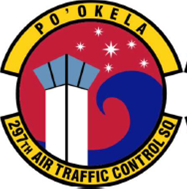History of the 297th Air Traffic Control Squadron
The unit relocated from the island of Hawaii to Barbers Point in 1981.
In November 1982, the 297 ATCF provided emergency generator support to residents of Kauai after the destruction of Hurricane Iwa.
In July 1987, the unit moved from its World War II vintage Quonset hut to its present modern facilities.
After Hurricane Iniki devastated Kauai September 11, 1992, the unit provided air traffic control services for military aircraft at Barking Sands, Kauai. Emergency generators and numerous personnel were deployed to support overall relief efforts. Numerous citations were awarded to unit members for outstanding humanitarian service.
In 1988, 1989 and 1993, the unit provided air traffic services and deployed their Air Traffic Control and Landing Systems in support of Team Spirit in the Republic of Korea. The 297 ATCF performed in an outstanding manner and became the first Air National Guard unit to perform this function overseas. Supporting Sentre Vigilance yearly since 1987, the 297 ATCF sends air traffic controllers to Volk Field, Wisconsin and Alpena, Michigan. At these locations, Sentre Vigilance trains controllers and both national guard and active duty flying units for Operational Readiness Inspections and operational exercises.
In May 1991, the unit was placed on stand-by alert by Pacific Air Forces to deploy and provide air traffic services at Bangladesh, India. Once again in demand the 297 ATCF assisted the active duty Air Force in Honduras by providing controllers for Fuertes Caminos, a nation building mission. By August 1992, the 297 ATCF again was placed on stand-by alert to deploy to Kadena AB, Okinawa, Japan. While standing alert in August of 1992, the unit provided emergency generator power for the Defense Information Systems Agency-Pacific (D1SA-PAC) alter the agency experienced a catastrophic power failure. Within a moments notice, the unil deployed equipment and personnel to sustain DISA-PAC’s operations. In September 1992, PACAF tasked the 297 ATCF to deploy its TRN-26. Tactical Air Navigation System (TACAN). to Yokota AB, Japan in support of the base TACAN modification program.
The deployed TACAN supported all flying requirements and redeployed home upon completion of the modification program in March 1993. Knowing his unit’s expertise, Pacific Air Forces tasked 297 ATCF radar maintenance personnel in February 1994 to tear down and pack a MPN- 14K, Landing Control Central (mobile radio), at Kunsan AB. Republic of Korea for redeployment to McClellan AFB, CA.
Since April 1996, the 297 ATCF has provided air traffic controllers, radio maintenance and TACAN maintenance for Operation Joint Endeavor to support active duty forces in Taszar, Hungary. This location is the primary airlift staging area for troop movement and supplies in and out for the Bosnia/ Herzegovina peacekeeping mission. Training activities and real world support reflect the continuing capability of unit members to provide dependable communications and air traffic control services anywhere in the world.
The 297 ATCF uses several equipment packages to accomplish its mission including the MPN-14K (Ground Control Approach Radar), TSW-7 (Mobile Control Tower), TRN-26 (Tactical Air Navigation System), mobile generators, and a fleet of tactical vehicles.
In December, ten members of the 297th Air Traffic Control Squadron deployed to Mosul, Iraq until Mar. 2005 in support of Operation Iraqi Freedom. This was the squadron’s second deployment in support of OIF.
2008 297th Air Traffic Control Squadron personnel continued to support AEF requirements with personnel deploying to both Iraq and Afghanistan. Nearly 300 ATCS airmen have supported operations in Iraq and Afghanistan multiple times since Sept. 11, 2001.
Last updated May 2020
Emblem

Blazon
On a disc Gules, in sinister chief a mullet of eight between five diminished mullets of eight each Argent, issuing from base a Tsunami cresting to dexter Azure, surmounted by an air traffic control tower issuing from dexter base arraswise of the second detailed Sable, its tower cab Celeste, detailed of the last, all within a narrow border Black. Attached above the disc, a Yellow scroll edged with a narrow Black border and inscribed “PO’ OKELA” in Black letters. Attached below the disc, a Yellow scroll edged with a narrow Black border and inscribed “297TH AIR TRAFFIC CONTROL SQ” in Black letters.
Significance
Ultramarine blue and Air Force yellow are the Air Force colors. Blue alludes to the sky, the primary theater of Air Force operations. Yellow refers to the sun and the excellence required of Air Force personnel. The air traffic control tower signifies the vigilance of the United States military and the support provided to maintain air traffic control. The tsunami symbolizes the crushing power elicited from the successful completion of the mission as well as the constant and steep “wave of change” in warfare. Within the group of stars, the large star represents the 201st Combat Communications Group. The remaining stars represent the five original squadrons within the Group.
Leadership
- Maj Joyce A. Merl
- Maj Mark S. Welch
- Maj James F. Wornall
